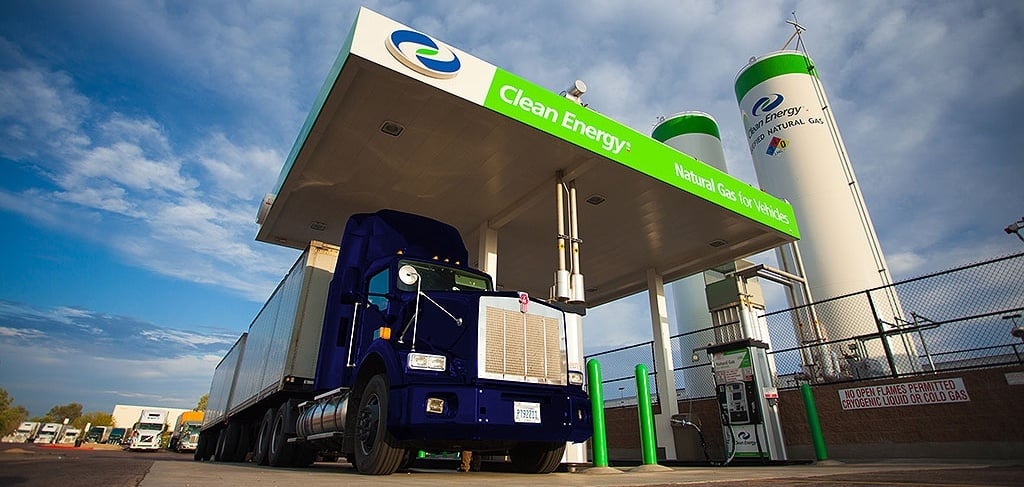This post is one in a series of feature stories on trends that shape advanced energy markets in the U.S. and around the world. It is drawn from Advanced Energy Now 2017 Market Report, which was prepared for AEE by Navigant Research.

In the early part of this decade, the deployment of non-traditional methods of natural gas extraction, especially hydraulic fracturing, both dramatically increased the availability of this fuel and drove down the price, making it a possible alternative to other fuels not only for power generation but also for transportation. The prospect of lower operating cost made it seem that NGVs could be a good solution for larger vehicle types (and vehicle fleets), despite higher purchase prices.
Since then, the growth of NGV has been hindered by the collapse of world oil prices in late 2014, which reduced the cost differential with gasoline and diesel. Still, other market drivers continue to make NGVs appealing in the coming decade, especially for larger trucks and buses. Tightening emissions regulations, particularly for diesel engines, could push fleets further toward natural gas conversions – and refueling infrastructure will follow.
While NGVs and refueling infrastructure for them have gained a significant foothold in several markets around the world, including parts of Western Europe and China, other markets like North America have lagged behind. Global natural gas fueling station revenue has been on a downward curve since 2011, when it was $2.1 billion, reaching $820 million in 2016. U.S. revenue for this fueling infrastructure peaked at $335 million in 2012 and had dropped to $110 million in 2016.
Two technical and economic challenges are central to the growth of NGVs: on-vehicle fuel storage and refueling infrastructure. Both CNG and LNG storage systems are more bulky and expensive than a gas tank. Although CNG has a significant cost advantage and is generally easier to handle during fueling, LNG has approximately 2.4 times the energy density and a corresponding advantage in driving range, making it more desirable for high-mileage applications such as long-haul trucking.
Refueling stations also face issues in cost, local regulatory approval, and ready access to gas supply. The cost of refueling stations ranges from as low as $50,000 for a station that can fuel four to eight vehicles a day to several million dollars for a high-capacity station. New examples of high-capacity stations include those installed in 2015 by Honda of America at its Marysville, Ohio, factory and Fiat Chrysler Automobiles (FCA) at its Detroit Truck Terminal. The Honda station was constructed and is operated by Trillium CNG, while TruStar Energy was responsible for the FCA facility.
The main regulatory driver for the use of natural gas as a transport fuel is emissions regulations. These include mandates to reduce emissions of greenhouse gases (GHGs), particulate matter (PM), and nitrogen oxides (NOx) in regions with more stringent regulations including the European Union, Japan, Canada, and the United States. In the United States, next-generation emissions standards being phased in during 2017 will begin to affect medium- and heavy-duty vehicles such as trucks and buses, while even light-duty vehicles (LDVs) will face tighter limits on PM and NOx, in addition to tighter fuel economy standards. According to the U.S. Department of Energy’s Argonne National Laboratory, light-duty NGVs emit 6% to 11% fewer full-lifecycle GHG emissions than comparable gasoline-fueled vehicles. The gap is wider when comparing diesel vehicles to CNG. The PM and NOx emissions from diesel-powered medium- and heavy-duty vehicles running in dense urban areas have a bigger impact on air quality, giving a significant advantage to natural gas alternatives. The cleaner emissions from NGVs also negate the need for expensive diesel exhaust after-treatment systems, which add to maintenance costs on these vehicles.
The market for NGVs and corresponding refueling infrastructure remains a mixed bag, and is highly dependent on vehicle segment and region. As with other alternatives to traditional liquid fuels, natural gas does not represent a universally viable competitor to gasoline and diesel for vehicles, though Navigant Research expects the market to grow. The global light-duty vehicle market is projected to grow to more than 105 million vehicles annually by 2026, along with another 6.2 million medium- and heavy-duty vehicles. NGVs are expected to account for more than 4.5 million light-duty and nearly 456,000 heavier-duty vehicles. As a result, the natural gas refueling infrastructure market is projected to grow at a 4.4% compound annual growth rate globally to a total of 39,300 locations by 2026.
The full report on the size of the advanced energy market is available for free at the link below:
